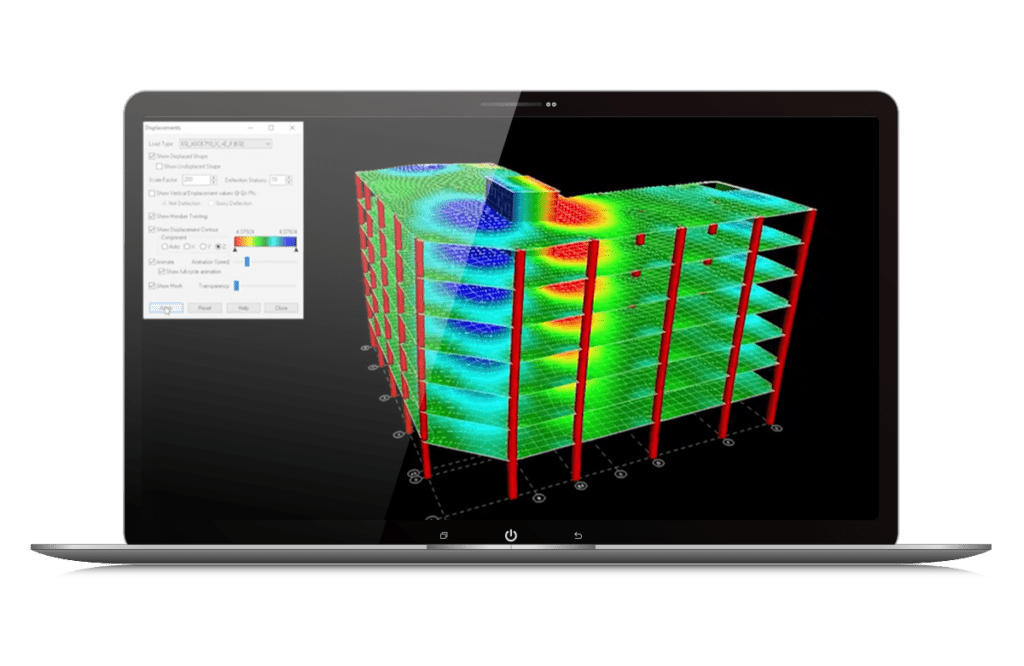
RAM Structural System
Integrated Structural Analysis and Design of Concrete and Steel Buildings
Work Your Way
Built by engineers for engineers.
Save countless hours with an intuitive modeling environment for concrete and steel-framed buildings. RAM Structural System provides you a complete solution for analysis, design, drafting, and documentation for steel and concrete buildings, foundations, and even individual structural components; all in compliance with your local building codes. With RAM, you will save time and money by automating the most tedious, repetitive, and time-consuming tasks so that you can focus on the more critical aspects of design and provide a cost-effective solution to your client.

Analyze
- Analyze the buildings’ lateral system for wind and seismic loads in the most practical way.
- Calculate gravity load distribution using methods tailored to specific framing systems.
Design
- Design structural steel and concrete elements, including foundations.
- Efficiently design safe, optimized concrete tilt-up walls.
Share
- Share structural data with applications such as Revit, Tekla, and OpenBuildings.
- Automatically update documentation including plans and elevations when changes are made to the 3D model.
RAM Structural System is an integrated 3D static and dynamic structural analysis and design solution that automates time-consuming tasks. The application helps engineers deliver projects on time and within budget. It is developed for concrete and steel-framed building systems subjected to lateral, dynamic, and gravity loads.
PERFORM ANALYSIS FOR ALL TYPES OF BUILDING STRUCTURES SUBJECTED TO STATIC AND DYNAMIC LOADS
RAM Structural System is a highly sophisticated analysis package that includes many time-saving features, unavailable in competing software packages. RAM Structural System accommodates a wide range of building structural configurations including flat concrete slabs, slab and beam systems, composite steel-framed floors, shear walls, moment frames, braced frames, isolated footings, strip footings, mat foundations, or a combination of these systems. Frames and walls can be of any building material including steel, concrete, masonry, or any combination of these materials. Gravity, wind, seismic, dynamic, and notional load cases are automatically generated and applied to the model.
AUTOMATICALLY OPTIMIZE DRIFT AND SHEAR-WALL DESIGN FORCE CALCULATIONS
Two powerful post-processing modules are integrated into RAM. This allows the engineer to easily optimize drift in the structure and obtain wall force information for further design. The Drift module graphically identifies those members with the most significant contribution to structure drift, allowing the engineer to easily optimize the member sizes to control drift. The Shear Wall Force post-processor provides design forces wherever needed, whether through piers, between wall openings, or between levels.
PRODUCE DETAILED REPORTS
RAM Structural System allows engineers to generate detailed reports in every step of analysis and design. Analysis results are reported for the structure as a whole and detailed reports for individual members are also provided. Many capabilities are available to interactively display analysis results graphically.


RAM Structural System At-A-Glance
TECHNICAL CAPABILITIES
- Static and dynamic analysis of buildings with moment frames, braced frames, shear walls and/or any combination of these systems
- Members with any material types, including steel, concrete, or user-defined materials
- Automated mesh generation for walls and diaphragms
- Analysis with tension-only members
- AISC 360 Direct Analysis Method option
- P-Delta analysis option
- Foundation springs
- Rigid, semirigid, and flexible diaphragms
- Construction sequence analysis
- Concrete creep and shrinkage analysis
- Automatic generation of steel and concrete design load combinations per specified code
- Automatic calculation of K-factors (effective length factors) and unbraced lengths, with user override capability
- Gravity loads distributed and applied to structural model in RAM Frame®
- Live load reduction factors automatically calculated
- Automatic calculation of member self-weights for beams, columns, walls, slabs, and decks
- Automatic generation of wind story forces per IS875, IBC, ASCE 7, UBC, BOCA, SBC, BS 6399, NBC of Canada, AS/NZS 1170.2, China GB 50011, and Eurocode
- Automatic generation of seismic story forces per IS1893, IBC, ASCE 7, UBC, BOCA, SBC, NBC of Canada, AS/NZS 1170.2, China GB 50011, and Eurocode
- Automatic calculation of notional loads based on dead, live, roof, and snow loads on diaphragms and on members, per IS800, AISC 360, BS 5950, BS 8110, CAN/CSA S16, AS 4100, or user-defined notional load cases
- Automatic calculation of structural mass properties (story mass, center of mass, and mass moment of inertia)
- Optional inclusion of effects of the offset of center of mass to account for accidental torsion moments
- Response Spectra analysis, with option for SRSS or CQC combination of modal results with signs, and option to consider eccentricity of story masses
Produce design documentation and detailed reports
Model quickly and accurately with customizable features and conform to your company standards. Customize toolbars, model views, display options, and unit systems and easily create templates so it’s easier to replicate on your everyday design structures and save time on every project.
- Animated deflected shapes
- Calculation of story drifts at any point in the structure
- Automatically generates CAD DXF export of frame and wall elevations
- Analysis and design results displayed graphically or in text format with ability to export
- Comprehensive material takeoff, including piece count and steel tonnage allowing for comparison of various design schemes
- ACI 318, AS 3600, EN 1992-1-1, GB 50010, and IS 456
- Concrete beam column and moment frame design including rebar layout and schedules
- Automatic pattern loading
- Wall design
- Member and joint design checks based on IS800, AISC 360 LRFD and ASD, AISC 9th ASD, AISC 3rd LRFD, BS 5950, CAN/CSA S16, AS 4100, and Eurocode
- Designs column web plates (doublers) and stiffeners (continuity plates) for wind and low seismic applications
- Automatically calculates effective length factors, flange bracing, and unbraced lengths
- Full interactive control for review and design refinement
Comply with seismic requirements
Design and detail seismic force-resisting systems, generating seismic loads according to the relevant building code.
- Performs additional special seismic code design and detailing checks for members and joints, based on AISC 341 ASD and LRFD, AISC 358 and 2002 LRFD, UBC 1997 LRFD and ASD, and FEMA 350
- Automatically generates seismic load combinations
- Supports all concentric braced frame, eccentric braced frame, and moment frame structural systems
- Considers reduced beam sections (dogbone) where applicable in moment-frame joint checks
- Analyzes and designs Star Seismic and CoreBrace Buckling Restrained Braces, SidePlate and DuraFuse Moment Frame connections, and Simpson Yield-Link®
- Supports all seismic zones for each seismic code
- Provides a functionality to study and control the drift behavior of buildings
Automatically optimize drift and shear-wall design force calculations
With integrated post-processing modules for drift and shear wall force, RAM Structural System helps engineers easily optimize designs. The Drift module graphically identifies members that have the most significant contribution to structure drift, so it’s easy to optimize member sizes to control drift. The Shear Wall Force post-processor provides design forces where needed, through piers, between wall openings, or between levels.
- Provides detailed analysis results for shears, moments, and axial forces in shear walls
- Allows the engineer to define vertical and horizontal section. Cuts through any cross-section on any wall
- Cross-section design based on combined forces and code requirements
- 2nd-order analysis for slenderness effect of thin walls
- Out-of-plane wind pressure
- Comprehensive modeling (including gaps and reveals), analysis, and design
FREQUENTLY ASKED QUESTIONS
RAM Structural System is structural design software for buildings. Bentley RAM Structural System helps structural engineers save time by automating tasks that are tedious, repetitive, and time-consuming.
Processor
Intel or AMD processor 2.0 GHz or greater
Operating System
Windows 10 and higher x 64 RAM 2 GB minimum recommended
Hard Disk
675 MB free disk space for installation
2 GB available for analyzing models
Display
OpenGL compatibility recommended.
For the most up-to-date system requirements, visit Bentley Communities.
